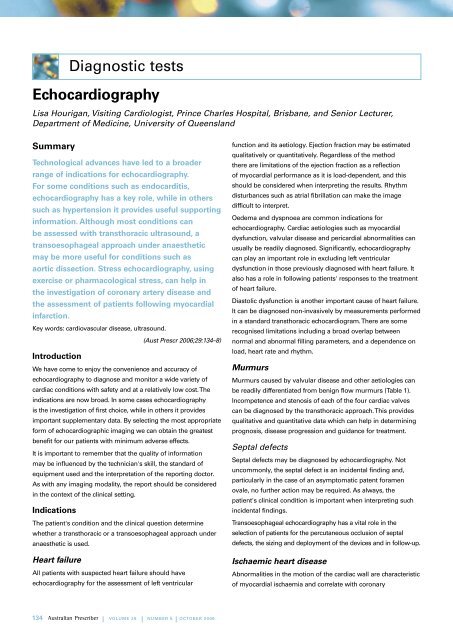download the full PDF issue - Australian Prescriber
download the full PDF issue - Australian Prescriber
download the full PDF issue - Australian Prescriber
You also want an ePaper? Increase the reach of your titles
YUMPU automatically turns print PDFs into web optimized ePapers that Google loves.
Diagnostic tests<br />
Echocardiography<br />
Lisa Hourigan, Visiting Cardiologist, Prince Charles Hospital, Brisbane, and Senior Lecturer,<br />
Department of Medicine, University of Queensland<br />
Summary<br />
Technological advances have led to a broader<br />
range of indications for echocardiography.<br />
For some conditions such as endocarditis,<br />
echocardiography has a key role, while in o<strong>the</strong>rs<br />
such as hypertension it provides useful supporting<br />
information. Although most conditions can<br />
be assessed with transthoracic ultrasound, a<br />
transoesophageal approach under anaes<strong>the</strong>tic<br />
may be more useful for conditions such as<br />
aortic dissection. Stress echocardiography, using<br />
exercise or pharmacological stress, can help in<br />
<strong>the</strong> investigation of coronary artery disease and<br />
<strong>the</strong> assessment of patients following myocardial<br />
infarction.<br />
Key words: cardiovascular disease, ultrasound.<br />
Introduction<br />
(Aust Prescr 2006;29:134–8)<br />
We have come to enjoy <strong>the</strong> convenience and accuracy of<br />
echocardiography to diagnose and monitor a wide variety of<br />
cardiac conditions with safety and at a relatively low cost. The<br />
indications are now broad. In some cases echocardiography<br />
is <strong>the</strong> investigation of first choice, while in o<strong>the</strong>rs it provides<br />
important supplementary data. By selecting <strong>the</strong> most appropriate<br />
form of echocardiographic imaging we can obtain <strong>the</strong> greatest<br />
benefit for our patients with minimum adverse effects.<br />
It is important to remember that <strong>the</strong> quality of information<br />
may be influenced by <strong>the</strong> technician's skill, <strong>the</strong> standard of<br />
equipment used and <strong>the</strong> interpretation of <strong>the</strong> reporting doctor.<br />
As with any imaging modality, <strong>the</strong> report should be considered<br />
in <strong>the</strong> context of <strong>the</strong> clinical setting.<br />
Indications<br />
The patient's condition and <strong>the</strong> clinical question determine<br />
whe<strong>the</strong>r a transthoracic or a transoesophageal approach under<br />
anaes<strong>the</strong>tic is used.<br />
Heart failure<br />
All patients with suspected heart failure should have<br />
echocardiography for <strong>the</strong> assessment of left ventricular<br />
134 | VOLUME 29 | NUMBER 5 | OCTOBER 2006<br />
function and its aetiology. Ejection fraction may be estimated<br />
qualitatively or quantitatively. Regardless of <strong>the</strong> method<br />
<strong>the</strong>re are limitations of <strong>the</strong> ejection fraction as a reflection<br />
of myocardial performance as it is load-dependent, and this<br />
should be considered when interpreting <strong>the</strong> results. Rhythm<br />
disturbances such as atrial fibrillation can make <strong>the</strong> image<br />
difficult to interpret.<br />
Oedema and dyspnoea are common indications for<br />
echocardiography. Cardiac aetiologies such as myocardial<br />
dysfunction, valvular disease and pericardial abnormalities can<br />
usually be readily diagnosed. Significantly, echocardiography<br />
can play an important role in excluding left ventricular<br />
dysfunction in those previously diagnosed with heart failure. It<br />
also has a role in following patients' responses to <strong>the</strong> treatment<br />
of heart failure.<br />
Diastolic dysfunction is ano<strong>the</strong>r important cause of heart failure.<br />
It can be diagnosed non-invasively by measurements performed<br />
in a standard transthoracic echocardiogram. There are some<br />
recognised limitations including a broad overlap between<br />
normal and abnormal filling parameters, and a dependence on<br />
load, heart rate and rhythm.<br />
Murmurs<br />
Murmurs caused by valvular disease and o<strong>the</strong>r aetiologies can<br />
be readily differentiated from benign flow murmurs (Table 1).<br />
Incompetence and stenosis of each of <strong>the</strong> four cardiac valves<br />
can be diagnosed by <strong>the</strong> transthoracic approach. This provides<br />
qualitative and quantitative data which can help in determining<br />
prognosis, disease progression and guidance for treatment.<br />
Septal defects<br />
Septal defects may be diagnosed by echocardiography. Not<br />
uncommonly, <strong>the</strong> septal defect is an incidental finding and,<br />
particularly in <strong>the</strong> case of an asymptomatic patent foramen<br />
ovale, no fur<strong>the</strong>r action may be required. As always, <strong>the</strong><br />
patient's clinical condition is important when interpreting such<br />
incidental findings.<br />
Transoesophageal echocardiography has a vital role in <strong>the</strong><br />
selection of patients for <strong>the</strong> percutaneous occlusion of septal<br />
defects, <strong>the</strong> sizing and deployment of <strong>the</strong> devices and in follow-up.<br />
Ischaemic heart disease<br />
Abnormalities in <strong>the</strong> motion of <strong>the</strong> cardiac wall are characteristic<br />
of myocardial ischaemia and correlate with coronary

















